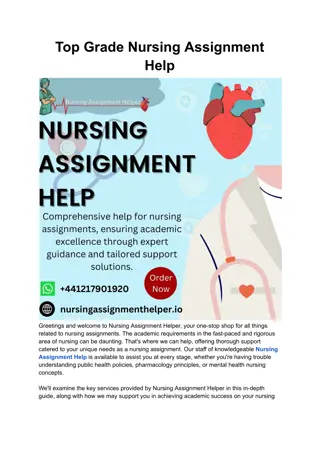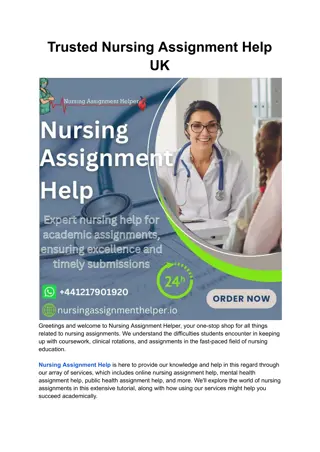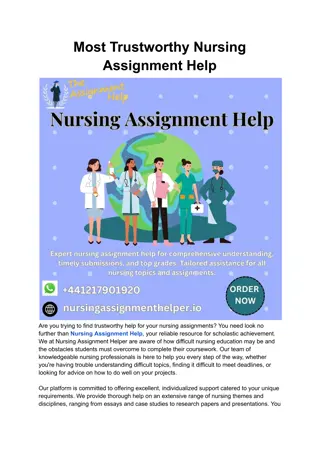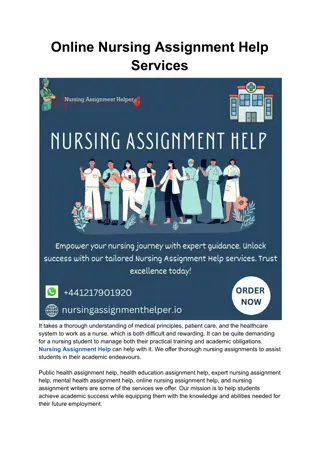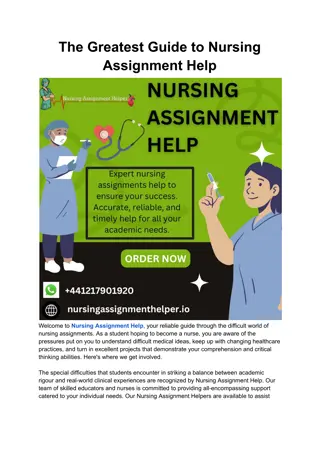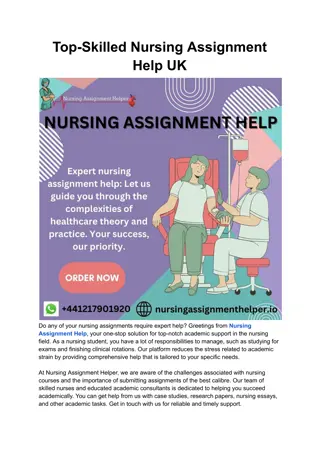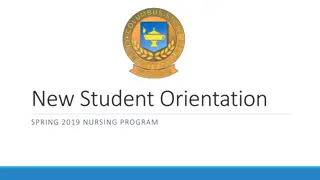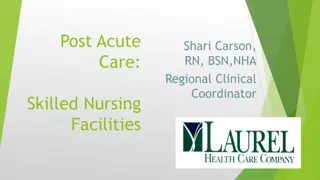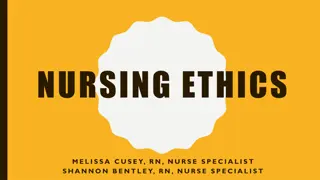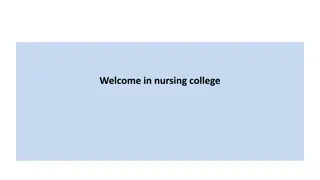Effective Study Techniques for Nursing Students
Enhance your nursing study skills with these valuable tips shared in a PowerPoint presentation by Sabina Monosova and credited to Margot R. De Sevo, PhD, RNC. The content emphasizes the importance of active learning, critical reading, and utilizing various sources of information to excel in nursing courses. Learn how to study nursing material effectively, engage with class notes, and analyze clinical practices to ensure alignment with theoretical concepts. These study techniques can help you prepare for exams and succeed in your nursing education journey.
- Nursing study skills
- Test-taking tips
- Effective learning strategies
- Nursing education
- Study techniques
Download Presentation

Please find below an Image/Link to download the presentation.
The content on the website is provided AS IS for your information and personal use only. It may not be sold, licensed, or shared on other websites without obtaining consent from the author. Download presentation by click this link. If you encounter any issues during the download, it is possible that the publisher has removed the file from their server.
E N D
Presentation Transcript
STUDYING NURSING: STUDY SKILLS AND TEST-TAKING TIPS PowerPoint by: Sabina Monosova Information Credited To: Margot R. De Sevo, PhD, RNC Associate Professor
NURSING COURSES V. OTHER ACADEMIC COURSES Most academic courses content-based only E.g. A & P of cardiac system learn structures of the system and their functions Nursing Profession applied science Must learn content AND use the information E.g. Care of the child with a cardiac defect learn about the defect, learn about children AND be able to determine the nursing care based on the child s age as well as his/her clinical status
TECHNIQUES FOR STUDYING NURSING CRITICALLY read the material BEFORE CLASS!!! identify key facts Pay attention to the headers cited by the authors. They often highlight key concepts ALWAYS focus on items in tables, boxes, figures, etc. Key facts or concepts may be included in tables, boxes, figures, etc. OR clarification of concepts may be included in the tables, boxes, figures, etc.
TECHNIQUES FOR STUDYING NURSING, CONT. WHY READ BEFORE CLASS When faculty lecture, students are passive. Content is not learned easily forgotten. If the content is read before class, faculty are able to clarify information. Questions can be asked by students. Case studies can be analyzed. Discussions can take place. Classes are more interesting and stimulating.
WHERE DO CLASS NOTES COME IN? After class, compare notes with the text Are they consistent? If NOT: Ask a fellow student maybe notes were taken incorrectly Ask the faculty member maybe he/she misspoke in class -- maybe new evidence has emerged books are 2-3 years out of date by the time they are published -- maybe there are differences in opinion there are often honest discrepancies between and among books
WHAT ABOUT OTHER SOURCES OF INFORMATION? Clinical watch and critique! Are you seeing nursing practice that is based on theory? If practice is inconsistent with what was in learned in the classroom or from another resource discuss the inconsistency with faculty!!
EXAMS EXAMS Consider classroom exams mini-clinical days Since most questions are based on the nursing process, each question is asking the test taker to make a clinical decision. Test takers must consider each scenario a clinical situation Studying MUST take place over time. Retention of material is impossible when studying occurs only days before an exam. SLEEP Research has shown that sleep is essential to learning. Students actually do LESS well when they stay up late and cram before exams. Plus, no nurse should enter a client s room having had too little sleep since an exam is a mini-clinical, NO student should enter an examination tired. Exhaustion can result in clinical errors.
HOW TO ANSWER EXAM HOW TO ANSWER EXAM QUESTIONS QUESTIONS READ! READ! READ! Stem The stem MUST be read carefully BEFORE reading the answers Cover up the answers The question being asked MUST be well understood After determining what is being asked, THINK OF POSSIBLE ANSWERS NOW Read ALL of the answers 1 by 1 If you KNOW the answer is wrong eliminate it immediately. If the answer you thought of is there PICK IT DON T second guess yourself If you are uncertain retain only possible answers. ALWAYS GUESS and don t waste time! Reviewing the exam NCLEX-RN Can t change answers On classroom exams ONLY CHANGE ANSWERS IF YOU KNOW THAT YOU MISREAD THE QUESTION THE FIRST TIME First impressions are almost always correct!!!
PRACTICE THE SKILL PRACTICE THE SKILL Test taking is a skill and ALL skills need to be practiced. Do as many questions as possible to practice the skill ATI practice exams www.ATItesting.com NCLEX-RN review books ALWAYS read why the correct answer was correct and why the incorrect answers were incorrect Understanding the rationale for answers is no different than understanding the rationales one s nursing care Time yourselves when doing practice questions Allow 1 minutes per question NCLEX-RN max number of questions -- 265 in 6 hours. Helps to simulate the time constraints in the classroom as well as the pressures of taking a test

 undefined
undefined








